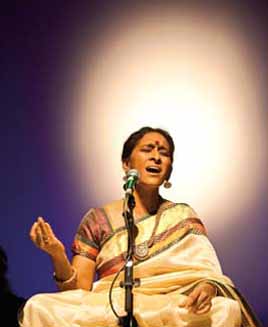NEWS & NOTES

Maverick Meera - GAYATHRI SUNDARESAN
The musical production Bhaire Baanwari – Explore the Divine, designed and directed by Gowri Ramnarayan, presented on 13th August at the Music Academy, Chennai was a unique experience in more ways than one. Meera’s story is one that everyone knows; what was different was the way her songs had been put together to bring out her life story.
Why Meera? Gowri says: “Meera continues to fascinate us even after five centuries. She is shaped more by legend than history. But these folk tales are authentic because they reflect our own aspirations. Meera spurned everything that the world could offer, in order to find something that the world could not give her”.
COVER STORY

Blessed by Hanuman - V. RAMNARAYAN
The Natyarangam award (see p. 50) could not have gone to a more worthy artist. For decades during the Rukmini Devi era, Balagopalan was one of the star performers at the annual Kalakshetra art festival. From his teen years to age sixty, when he retired, he remained the enthusiastic, devoted dancer, springing with the sprightly vigour that made him an early favourite of the grande dame of that institution.
A scene from Choodamani Pradanam, a Kalakshetra production in the Ramayana series several years ago. A forlorn Seeta is sitting under a tree and bemoaning her fate when Hanuman jumps down from a tree and surprises her
into open-mouthed wonder.
Even as the audience waits with bated breath, for it knows what power and artistry the dancer playing the monkey-god is capable of, the curtains have to be brought down hurriedly, as he has evidently twisted his ankle rather nastily.
It is, indeed, a bad injury and the foot swells like a balloon. A doctor in the audience happens to have just the right medical supplies in hand, and soon C.K. Balagopalan, the veteran dancer playing Hanuman, is administered an injection that numbs the injured area, and he is able to resume dancing as if nothing has happened.
MY GURU

Padmavathy Ananthagopalan - JAYANTHI KUMARESH
Vidushi Padmavathy Ananthagopalan. A rare shining jewel of the music fraternity, an inspiration for many aspiring musicians and vainika-s, a true example of a musical karma yogi. Her connection with music and veena is profound. She has evolved her own style to converse with the instrument which is full of dignity, grace and compassion.
A serious but calm face with a big kumkumam pottu, a simple ‘kondai’, a subtle smile, and a dignified look. The first time I set my eyes on her was when I was three. Even at that age I could sense something impressive about this petite, strong, disciplined lady, different from everyone else in the family.
With musicians in the family for the last seven generations, its members fit into a mould. Whenever I think about Lalgudi Mama, I am reminded of J.S. Bach’s Jonathan Livingston Seagull, which scaled newer altitudes and horizons in an eternal quest for something new, fresh and creative, an inspiring flight of everlasting creativity. He was the towering light shedding his glowing brightness on the entire family.
SPECIAL FEATURE

FROM THE SRUTI ARCHIVES
The Lalgudi legacy (Part II of a profile of Lalgudi G. Jayaraman) GOWRI RAMNARAYAN
An unpublished article written in 1985.
“Sometimes plantain shrubs grew thickly as far as the eye could see, at others sugarcane crops lined the fields with vernal crowns on purple stalks. At times ahathikeerai trees put out fresh leaves encircled by betel creepers, their two different greens gladdened the heart”. The boy took long walks in rapture. He waded through murmuring brooks or sat dangling his feet in the gurgling pools. All this provided physical relaxation and mental freedom. Life began and ended within the single street for the village dweller. Outings meant such walks or attending temple rituals at the end of the street. At the most a travel to neighbouring villages or nearby temple towns. The great world wagged busily past with its political storms and social upheavals all of which hardly touched the villager, content in his narrow native habitat. This cocooned life was invaluable for a vidyarthi’s concentration. Physical circumstances might have cabined and confined him. But nothing cramped his mind. He was exploring vast regions of sound and technique. His spirit was imbibing great draughts of freedom. Jayaraman bemoans the lack of such a gestation or incubation period in the life of today’s youth, for his own children.
We now move on to 1942 with its two significant events. It was the year of Jayaraman’s violin arangetram, the year of his initiation into adulthood through upanayanam, both serious in intent though conducted with an easy informality. The former took place in Saptarisheeswara Swami’s presence at the Lalgudi temple in the form of a violin-duet played by father and son. There was no fanfaronade, only family and close friends attended. The boy felt no special shyness as he had been used to playing every Friday evening in his home before much the same audience. “In fact, the only time I felt self conscious was when I first played with a mike in front of me. To adjust to the overwhelming novelty of hearing an echo of what I played (amplified at that) was very difficult at first.” He does not remember anything memorable connected to his arangetram.


